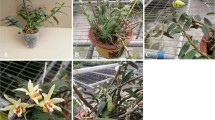Abstract
A survey of the inhibition of the amplification of spinach DNA by various plant polysaccharides revealed that neutral polysaccharides (arabinogalactan, dextran, gum guar, gum locust bean, inulin, mannan, and starch) were not inhibitory. In contrast, the acidic polysaccharides (carrageenan, dextran sulfate, gum ghatti, gum karaya, pectin, and xylan)were inhibitory. In the process of preparing random amplified polymorphic DNAs (RAPDs), the loss of large DNA bands appears to be an indicator that the fingerprint pattern has been affected by polysaccharides. The addition of various concentrations of Tween 20, DMSO, or PEG 400 to the PCR reaction mixture resulted in partial restoration of amplification of RAPDs for the acidic polysaccharides. The most effective way to eliminate the effects of polysaccharide inhibition was by diluting the DNA extracts, and thereby diluting the polysaccharide inhibitors.
Similar content being viewed by others
Abbreviations
- RAPD:
-
random amplified polymorphic DNA
References
Caetano-Anolles, G., B.J. Bassam and P.M. Gresshoff. 1994. Multiple arbitrary amplicon profiling using short oligonucleotide primers, pp. 29–45 inPCR Technology: Current Innovations. (eds. H.G. Griffin, A.M. Griffin). CRC Press, Boca Raton.
Demeke, T., and R.P. Adams. 1992. The effect of plant polysaccharides and buffer additives of PCR. Bio Techniques 12:332–334.
Demeke, T., and R.P. Adams. 1994. The use of PCR-RAPD analysis in plant taxonomy and evolution, pp. 179–192 inPCR Technology: Current Innovations. (eds. H.G. Griffin, A.M. Griffin). CRC Press, Boca Raton.
Do, N., and R.P. Adams. 1991. A simple technique for removing plant polysaccharide contaminants from DNA. Bio Techniques 10:162–166.
Doyle, J.J., and J.L. Doyle. 1987. A rapid DNA isolation procedure for small quantities of fresh quantities of fresh leaf tissue. Phytochem. Bull. 19:11–15.
Gelfand, D.H. 1989. Taq DNA Polymerase, p. 17–22 inPCR Technology. (ed. H.A. Erlich). Stockton Press, New York.
Pomp, D., and J.F. Medrano. 1991. Organic solvents as facilitators of polymerase chain reaction. Bio Techniques 10:58–59
Smith, F., and R. Montgomery. 1959. The chemistry of plant gums and mucilages and some related polysaccharides. Reinhold Publishing, New York.
Author information
Authors and Affiliations
Rights and permissions
About this article
Cite this article
Pandey, R.N., Adams, R.P. & Flournoy, L.E. Inhibition of random amplified polymorphic DNAs (RAPDs) by plant polysaccharides. Plant Mol Biol Rep 14, 17–22 (1996). https://doi.org/10.1007/BF02671898
Issue Date:
DOI: https://doi.org/10.1007/BF02671898




